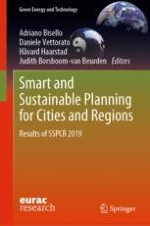2021 | OriginalPaper | Chapter
The Ecobonus Incentive Scheme and Energy Poverty: Is Energy Efficiency for All?
Author : Chiara Martini
Published in: Smart and Sustainable Planning for Cities and Regions
Publisher: Springer International Publishing
Activate our intelligent search to find suitable subject content or patents.
Select sections of text to find matching patents with Artificial Intelligence. powered by
Select sections of text to find additional relevant content using AI-assisted search. powered by
